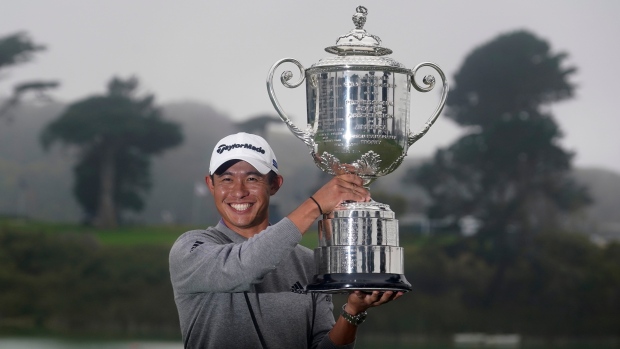Aug 11, 2020
Morikawa part of generation that is ready to win big
Four blue dots painted on the edge of the 16th tee at Harding Park on the day after the PGA Championship were all that marked the spot where Collin Morikawa hit a drive that will be talked about for years.
The Canadian Press

SAN FRANCISCO — Four blue dots painted on the edge of the 16th tee at Harding Park on the day after the PGA Championship were all that marked the spot where Collin Morikawa hit a drive that will be talked about for years.
Four dots for the fourth round.
The markers were set forward Sunday to make the hole play 294 yards, a risk-reward moment down the stretch with a major championship on the line. Monterey Cypress trees were to the right. Lake Merced was to the left.
The 23-year-old Californian took the straight and narrow. The ball bounded onto the green to 7 feet, setting up an eagle that effectively won it for him.
Those dots should mark the spot for a plaque to commemorate a shot that rates among the most memorable in a major.
Jack Nicklaus has a plaque on the 18th fairway at Baltusrol, where his 1-iron in 1967 allowed him to set the U.S. Open scoring record. Arnold Palmer has one on the 16th at Royal Birkdale for the 6-iron he slashed out of the high grass, key to his 1961 British Open title. The plaque on the 18th at Oak Hill is for Shaun Micheel and that 7-iron from 175 yards he hit to 2 inches to clinch his 2003 PGA Championship title.
Tiger Woods probably should have one behind the 16th green at Augusta National for his famous pitch that hung on the edge of the cup for a full second in his 2005 Masters victory. The club doesn't do plaques, only fountains.
Any plaque for Morikawa might describe more than the shot and the moments. Perhaps it could commemorate the start of a new era in golf, one filled with youth and devoid of fear.
That a player that young — not just 23 but in only his 28th start as a pro worldwide — won a major is not new. Woods was 21 when he won the Masters in his 18th pro start, setting 20 records along the way. In his 18th event as a pro, a 22-year-old Nicklaus won the U.S. Open at Oakmont in a playoff over Palmer, the hometown hero.
Morikawa joined a short list of players who won their first major at 23 or younger, which includes Nicklaus, Woods, Jordan Spieth, Rory McIlroy, Seve Ballesteros and Jerry Pate over the last half-century of golf.
But now it seems to be part of the norm.
The Wanamaker Trophy could have just as easily gone to 21-year-old Matthew Wolff, who grew up with Morikawa in Southern California. Every player would love a shot or two back at any major. Wolff had a stretch early on the front nine where he missed consecutive birdie chances from 7 feet and a par putt from half that range.
PGA Tour rookie Scottie Scheffler was right there until the final hour. He had a steady diet of birdie opportunities from the 20-foot range and didn't make enough.
To say Morikawa has a bright future is to suggest the Wanamaker Trophy is heavy with a loose lid. It's not about predicting greatness because that takes time. Spieth had three majors at age 23 and hasn't won since then.
Spieth was part of a high school class of 2011 that includes Justin Thomas, Xander Schauffele and Daniel Berger. Consider this next wave: Morikawa was runner-up twice for the Hogan Award as the nation's best college player, most recently to Viktor Hovland, who joined Wolff and Morikawa as PGA Tour winners since leaving college last summer.
It seems that now more than ever the amateurs who turn pro are not interested in any apprenticeship.
“I don't know about you guys, but yeah, I've believed in myself since day one,” Morikawa said. He then recalled last summer at the Travelers Championship and the group interview with Wolff, Hovland and Justin Suh.
“We all believed since day one that we can do this," Morikawa said. “I haven't let up from that.”
Wolff beat Morikawa in Minnesota last year with a long eagle putt on the last hole — Morikawa's eagle putt to force a playoff burned the edge. Three weeks later, Morikawa won his first PGA Tour title at the Barracuda Championship.
Morikawa, Wolff and Hovland are all among the top 40 in the world just over a year since leaving college. Not to be overlooked is that old man, 25-year-old Jon Rahm, who in the four years since he graduated from Arizona State already has 10 victories worldwide and the No. 1 world ranking.
“I think you're seeing guys come out and win, which is pretty cool,” Scheffler said. “I guess it's some sort of arrival, if you want to say that.”
It used to be rare for a player to go from college to a PGA Tour card with no detour in between. Phil Mickelson won as an amateur. Tiger Woods won on a sponsor's exemption in his fifth start. They never had to go to Q-school.
Now the path is a year on the Korn Ferry Tour. Rahm avoided that in 2016 by securing his card in four tournaments. Morikawa, Wolff and Hovland all went from college to the tour in a matter of months.
Anymore, the question seems to be not what happened, but who's next?
